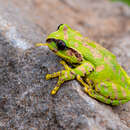Description
provided by AmphibiaWeb articles
A medium-sized arboreal Leptopelis (males 28-43 mm, females 39-50 mm) from montane forests (1900-3100 m) on the Ethiopian plateau. Phase A often with a darker triangle on the back, never confluent with the interorbital bar. Ventrum white or cream. Males with pectoral glands.Colour in life. - Phase A: dorsum pale greenish-yellow, bright green or dark olive, typically without darker markings. Phase B cream, pale grey or greenish to dark red-brown above with a feeble to very pronounced pattern of darker blotches, spots and freckling. These markings, grey or green to dark brown or black, form a more or less conspicuous triangle or rectangular mass on the back, never confluent with the interorbital bar. Usually a series of irregular blotchesin the sacral region. Limbs with more or less well-defined transverse bars. Few to numerous cream to bright yellow spots may be irregularly scattered over dorsum. A distinct pale line nearly always present above vent and heel. Ventrum white or cream, usually lightly mottled with pale grey to heavily blotched or even completely suffused with dark purplish-brown.Voice. - The males call from low vegetation in the vicinity of streams, not always particularly close to water. They tend to select a vantage point 25-200 cm above the ground. The voice is a rather sharp "click" somewhat higher-pitched that that of L. gramineus. It is sometimes preceded by a low scream or creaking sound.This account was taken from "Treefrogs of Africa" by Arne Schiøtz with kind permission from Edition Chimaira (http://www.chimaira.de/) publishers, Frankfurt am Main.
Distribution and Habitat
provided by AmphibiaWeb articles
Leptopelis ragazzii appears to be endemic to the central plateau of Ethiopia and rather strictly associated with montane forest
Life History, Abundance, Activity, and Special Behaviors
provided by AmphibiaWeb articles
Development. - Largen once observed a pair in amplexus on the ground in long grass beside a small stream.

